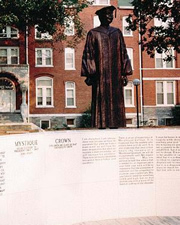Thu 19 Feb, 2009
The struggles of historically black colleges and universities
Comment now Filed under: Thinking about race, privilege and inequalityTags: Education, Historically black colleges and universities, Racial inequality
 Apparently, historically black colleges and universities are being disproportionately affected by the current economic recession, because they tend to have smaller endowments and a higher proportion of students from disadvantaged backgrounds.
Apparently, historically black colleges and universities are being disproportionately affected by the current economic recession, because they tend to have smaller endowments and a higher proportion of students from disadvantaged backgrounds.
Some of these hard-hit institutions include Morris Brown College, Clark Atlanta University, and Spelman College in Atlanta; Stillman College in Tuscaloosa, Ala.; and Tennessee State University in Nashville. Howard University, in Washington, D.C, is the wealthiest of these institutions, but even Howard has recently been forced to devote more funds to scholarships for its students.
It seems to me that two very different conclusions could be drawn from this development.
First, it is possible to see the struggles of historically black colleges and universities (HBCUs) in tough economic times as yet another indication that blacks in the United States continue to face significant disadvantages and that HBCUs should be supported in their continuing mission to educate disadvantaged students.
Many of these schools are facing greater challenges than other institutions because they tend to be less wealthy and more dependent on current income from student tuition. Meanwhile, those same students tend to be less able to pay tuition, being more likely than students at most institutions to be dependent upon financial aid and federal programs such as Pell Grants. These are precisely the sort of institutions and students who deserve support during an economic downturn.
Second, however, one could instead draw the lesson that it would be better not to support historically black colleges and universities at all.
The argument here would be that this situation merely illustrates the folly of relying on institutions which are defined in terms of race, when our society should be aiming to become more race-neutral. HBCUs performed a vital mission in a vastly different historical era, but perhaps they have largely outlived their usefulness as distinctive institutions.
After all, fully integrated colleges and universities are better equipped to ride out economic downturns. Their more diverse student and alumni populations enable them to accumulate larger endowments, rely less heavily on current income from tuition, and better support their less advantaged students by relying on tuition paid by students from more privileged backgrounds.
I have to suspect that there is a measure of truth in both of these reactions. Many of us would instinctively like our society to strive to be as color-blind as possible, not merely in the far-off future, but today. It may be telling that there seems to be practical advantages to using integrated institutions of higher education as a primary means of educating students from disadvantaged backgrounds of all kinds.
However, trying to be race-neutral in all respects would inevitably also paper over important aspects of our society’s racial inequality. One of the roles of today’s HBCUs, it would seem, is to ensure that we do not lose sight of those who are struggling to earn an education in tough economic times, particularly those for whom race is a factor.
After all, black students face disproportionate challenges at mainstream institutions of higher education, too. In fact, they often fare better at HBCUs. This is why HBCUs educate only 12% of black students but graduate 20%, and why they have produced 70% of our nation’s black doctors and dentists and 50% of our black engineers. The problem is that mainstream institutions may often attract black students who face fewer economic and other challenges, and the particular struggles of black students may go largely undetected in more diverse student bodies.
Perhaps one role of historically black colleges and universities today is to draw attention to one of the living consequences of our nation’s history of slavery and discrimination. Instead of masking that legacy in large, integrated, ostensibly race-neutral institutions, where racial injustice can often pass unnoticed, we can see the challenge for what it is, and address that legacy head-on.